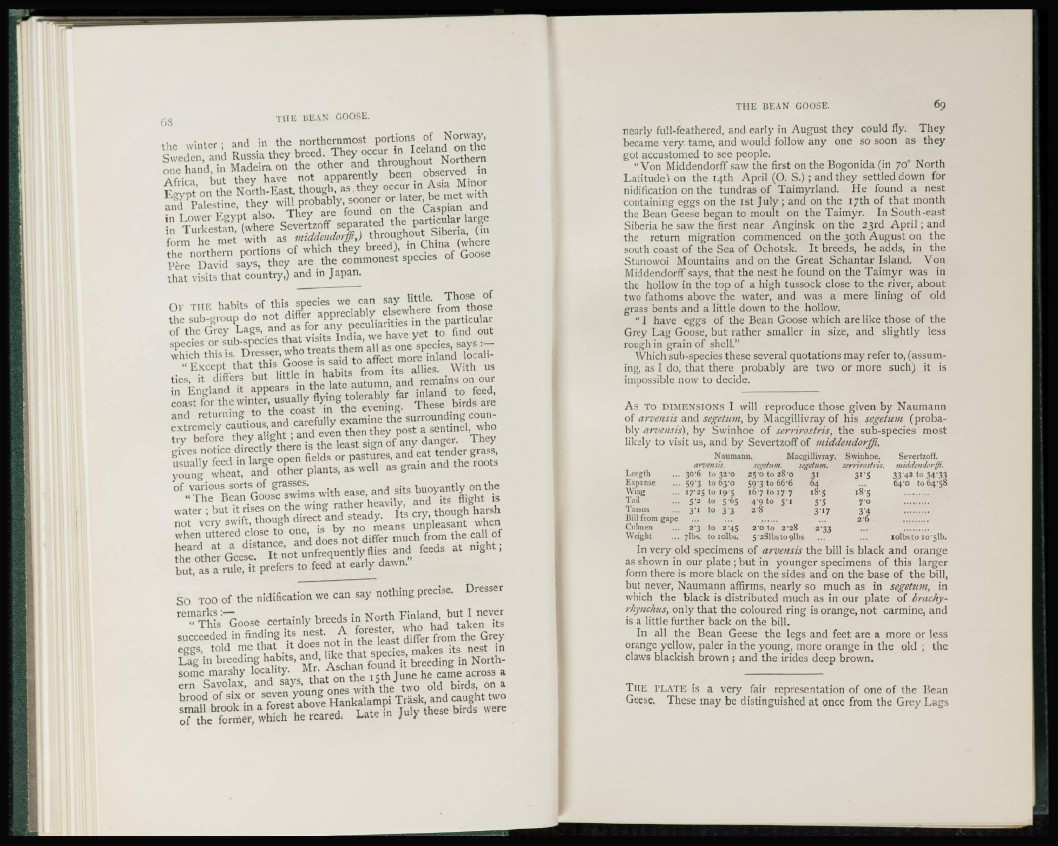
the winter ; and in the northernmost portions of Norway,
Sweden, and Russia they breed. They occur in Iceland on the
one hand, in Madeira on the other and throughout Northern
Africa, but they have not apparently been observed in
Egypt on the North-East, though, as they occur in Asia Minor
and Palestine, they will probably, sooner or later, be met with
in Lower Egypt also. They are found on the Caspian and
in Turkestan, (where Severtzoff separated the particular large
form he met with as middeudorffi,) throughout Siberia, (in
the northern portions of which they breed), in China (where
Pere David says, they are the commonest species of Goose
that visits that country,) and in Japan.
OF THE habits of this species we can say little. Those of
the sub-group do not differ appreciably elsewhere from those
of the Grey Lags, and as for any peculiarities in the particular
species or sub-species that visits India, we have yet to find out
which this is. Dresser, who treats them all as one species, says :—
" Except that this Goose is said to affect more inland localities,
it differs but little in habits from its allies. With us
in England it appears in the late autumn, and remains on our
coast for the winter, usually flying tolerably far inland to feed,
and returning to the coast in the evening. These birds are
extremely cautious, and carefully examine the surrounding country
before they alight ; and even then they post a sentinel, who
gives notice directly there is the least sign of any danger. They
usually feed in large open fields or pastures, and cat tender grass,
young wheat, and other plants, as well as grain and the roots
of various sorts of grasses.
" The Bean Goose swims with ease, and sits buoyantly on the
water ; but it rises on the wing rather heavily, and its flight is
not very swift, though direct and steady. Its cry, though harsh
when uttered close to one, is by no means unpleasant when
heard at a distance, and does not differ much from the call of
the other Geese. It not unfrequently flies and feeds at night;
but, as a rule, it prefers to feed at early dawn."
So TOO of the nidification we can say nothing precise. Dresser
remarks:—
" This Goose certainly breeds in North Finland, but I never
succeeded in finding its nest. A forester, who had taken its
eggs, told me that it does not in the least differ from the Grey
Lag in breeding habits, and, like that species, makes its nest in
some marshy locality. Mr. Aschan found it breeding in Northern
Savolax, and says, that on the 15th June he came across a
brood of six or seven young ones with the two old birds, on a
small brook in a forest above Hankalampi Trask, and caught two
of the former, which he reared. Late in July these birds were
nearly full-feathered, and early in August they could fly. They
became very tame, and would follow any one so soon as they
got accustomed to see people.
"Von Middendorff saw the first on the Bogonida (in 70° North
Latitude) on the 14th April (O. S.) ; and they settled down for
nidification on the tundras of Taimyrland. Pie found a nest
containing eggs on the 1st July ; and on the 17th of that month
the Bean Geese began to moult on the Taimyr. In South-east
Siberia he saw the first near Anginsk on the 23rd April ; and
the return migration commenced on the 30th August on the
south coast of the Sea of Ochotsk. It breeds, he adds, in the
Stanowoi Mountains and on the Great Schantar Island. Von
Middendorff says, that the nest he found on the Taimyr was in
the hollow in the top of a high tussock close to the river, about
two fathoms above the water, and was a mere lining of old
grass bents and a little down to the hollow.
" I have eggs of the Bean Goose which are like those of the
Grey Lag Goose, but rather smaller in size, and slightly less
rough in grain of shell."
Which sub-species these several quotations may refer to, (assuming,
as I do, that there probably are two or more such) it is
impossible now to decide.
As To DIMENSIONS I will reproduce those given by Naumann
of arvensis and segetum, by Macgillivray of his segetum (probably
arvensis), by Swinhoe of serrirostris, the sub-species most
likely to visit us, and by Severtzoff of middeudorffi.
Naumann. Macgillivray. Swinhoe. Severtzoff.
arvensis. segetum. segetum. serrirostris. middendorffi.
Length ... 30-6 to 32*0 25,oto28-o 31 31-5 3342 to 34-33
Expanse ... 59-3 to 63*0 50/3 to 66-6 64 ... 64'a to 64-53
Wing ... 17-251019-5 167 to 17 7 18-5 18-5
T a i l ••• 5'2 to 5-65 4-9 to 5-1 5-5 70
Tarsus ... 3-1 to 33 z-8 3-17 34
Bill fiom gape ... ... ... 2'6
Oilmen ... 2-3 to 2-45 20 to 2-28 2-33 ...
Weight ... 7lbs. to lolus. 5-281bsto 9lbs ... ... lolbsto io'Slb.
In very old specimens of arvensis the bill is black and orange
as shown in our plate ; but in younger specimens of this larger
form there is more black on the sides and on the base of the bill,
but never, Naumann affirms, nearly so much as in segeium, in
which the black is distributed much as in our plate of brachyrhynchus,
only that the coloured ring is orange, not carmine, and
is a little further back on the bill.
In all the Bean Geese the legs and feet are a more or less
orange yellow, paler in the young, more orange in the old ; the
claws blackish brown ; and the irides deep brown.
THE PLATE is a very fair representation of one of the Bean
Geese, These may be distinguished at once from the Grey Lags